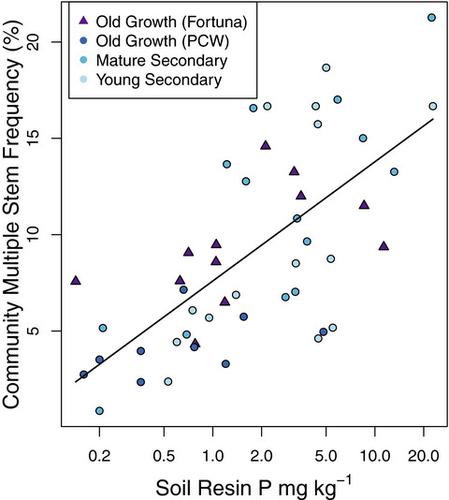Our official English website, www.x-mol.net, welcomes your
feedback! (Note: you will need to create a separate account there.)
Nutrient availability predicts multiple stem frequency, an indicator of species resprouting capacity in tropical forests
Journal of Ecology ( IF 5.3 ) Pub Date : 2021-01-09 , DOI: 10.1111/1365-2745.13585 Katherine D. Heineman 1 , Benjamin L. Turner 2 , James W. Dalling 1, 2
中文翻译:

营养物的供应量预测多茎频率,这是热带森林物种繁殖能力的指标
更新日期:2021-01-09
Journal of Ecology ( IF 5.3 ) Pub Date : 2021-01-09 , DOI: 10.1111/1365-2745.13585 Katherine D. Heineman 1 , Benjamin L. Turner 2 , James W. Dalling 1, 2
Affiliation

|
- Resprouting capacity is a key component of plant life history. While resprouting requires substantial nutrient reserves to support new growth, the influence of soil fertility on resprouting is largely unknown.
- We tested whether the frequency of multi‐stemmed trees, a potential indicator of resprouting history, is associated with low soil fertility, reflecting selection for conservative life histories that enhance survival, or with high fertility, reflecting greater resource availability to support regrowth.
- Data from the Barro Colorado Island (BCI) 50‐ha plot in Panama showed that multi‐stemmed trees are more likely to resprout during their lifetime than single‐stemmed trees, and that multiple stem frequency has a strong taxonomic signal for adult trees.
- To test how multiple stem frequency varies with demographic rates and nutrient allocation strategies, we compiled functional trait datasets for 71 species from lowland forest on BCI and 43 species from lower montane forest in western Panama. We also assessed environmental correlates of community‐wide multiple stem frequency in thirty‐seven 1‐ha lowland plots in the Panama Canal watershed and twelve 1‐ha montane plots in western Panama, spanning gradients of rainfall and soil fertility.
- Multiple stem frequency was not correlated with species demographic rates or wood density, suggesting that resprouting is unrelated to classical ‘persistence’ traits in neotropical tree species. Multiple stem frequency of tree species occurring on BCI was weakly but significantly positively correlated with regional soil phosphorus associations, but unrelated to foliar nutrient concentrations.
- Multiple stem frequency covaried strongly with soil and tissue nutrient status across fertility gradients. It was significantly positively correlated with nutrient allocation traits, including foliar phosphorus and wood nitrogen and phosphorus, among species sampled across soil habitats in western Panama. At the community level, the proportion of woody stems >10 cm DBH with at least one multiple stem increased with plant available soil phosphorus.
- Synthesis. These results suggest a novel mechanism by which soil phosphorus availability influences tree recruitment and forest dynamics by facilitating resprouting. Future experiments should seek to understand whether soil fertility mediates resprouting frequency through nutrient supply directly, or via the formation of enhanced wood nutrient reserves.
中文翻译:

营养物的供应量预测多茎频率,这是热带森林物种繁殖能力的指标
- 再生能力是植物生命史的关键组成部分。虽然重新萌发需要大量养分以支持新的生长,但土壤肥力对重新萌发的影响却鲜为人知。
- 我们测试了多茎树木的发生频率是否是重生史的潜在指标,它是否与土壤肥力低,反映出可以提高生存率的保守性生活史的选择有关,还是与土壤肥力高,反映了支持再生长的更大资源可用性有关。
- 巴拿马Barro科罗拉多岛(BCI)50公顷地块的数据表明,多茎树木比一茎树木更有可能在其一生中萌芽,而且多茎频率对成年树木有很强的分类学信号。
- 为了测试多茎频率如何随人口统计学和营养分配策略的变化,我们为BCI的低地森林和巴拿马西部的低山地森林的43种植物编制了功能性状数据集。我们还评估了巴拿马运河流域的37个1公顷低地小区和巴拿马西部的12个1公顷山地小区的社区范围内多茎频率的环境相关性,这些降雨跨越了土壤肥力梯度。
- 多茎频率与物种人口统计率或木材密度无关,这表明重新发芽与新热带树种的经典“持久性”特征无关。在BCI上发生的树种的多茎频率与区域土壤磷的相关性较弱,但显着正相关,但与叶面养分浓度无关。
- 在不同的肥力梯度下,多茎频率与土壤和组织养分状况密切相关。在巴拿马西部土壤生境中采样的物种中,它与养分分配特征(包括叶面磷,木材氮和磷)显着正相关。在社区一级,随着植物可利用的土壤磷的增加,木质茎秆> 10 cm DBH且至少有一个复茎的比例增加。
- 综合。这些结果提出了一种新的机制,土壤磷的可利用性通过促进发芽来影响树木的募集和森林动态。未来的实验应设法了解土壤肥力是通过直接供应养分还是通过增加木材养分储备来调节发芽频率。











































 京公网安备 11010802027423号
京公网安备 11010802027423号